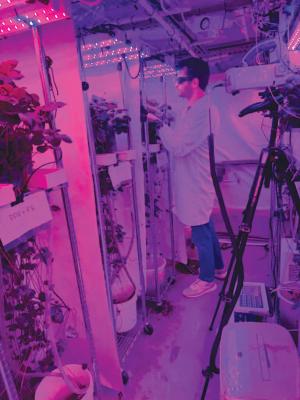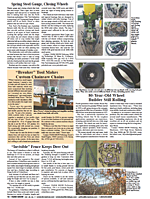Research Yields Increase In Strawberry Plants
 ✖  |
NCSU PhD student Moein Moosavi is revolutionizing strawberry starter production. He’s developed a process to produce 1,200 daughter plants per square meter, compared to 74 to 98 with traditional in-field production. Moosavi uses indoor hydroponic propagation under artificial lighting.
“The U.S. is the second-largest producer of strawberries in the world, worth over $2.3 billion annually,” says Moosavi. “All those farms need to start with healthy planting materials (daughter plants or tips). Right now, most of our planting stock comes from open-field nurseries in California, where plants are grown in soil and fumigated with methyl bromide to control diseases.”
He explains that the fumigant is under strict regulation. At the same time, open field propagation is labor-intensive. Flowers need to be removed, and daughter plants pinned to the soil.
In Moosavi’s system, the mother plant is on top, and the stolons hang down. They never touch soil and are pest-free. He precisely controls growing conditions and reduces variability caused by weather, pests and diseases.
“The main focus of my research is figuring out how to encourage those stock plants (by adjusting light duration, intensity, spectrum and other signals) to make fewer flowers and more stolons and daughter plants,” says Moosavi.
High-quality, vigorous, disease-free and more uniform daughter plants can lead to better field establishment, higher yields and a lower risk of disease, explains Moosavi.
“This is important to North Carolina growers as it could reduce reliance on distant nurseries and imported plants, giving growers more local or even on-farm options for producing their own planting materials,” he says. “North Carolina is one of the top three strawberry-producing states in the U.S. We’ve got around 2,000 acres in plasticulture production.”
The protocols he developed for daughter plant protection could well lend themselves to breeding new cultivars with the potential to shorten breeding cycles. Primarily, he sees them being utilized at the plant stock distributor or nursery level.
However, they may also be helpful for small growers.
“Some aspects, like figuring out optimal lighting strategies, could also help small-scale growers who want to produce their own transplants or maintain elite mother plants for small-scale, on-farm production.”
The American Society for Horticultural Science (ASHS) recently named him a recipient of the 2025 ASHS Outstanding Graduate Horticulture Student Award. He’s also received several other recognitions for his graduate student research.
Moosavi was raised on a family farm with a large garden in eastern Iran. Experiencing the difficulties of farming in the drought-prone region, he chose to study horticulture and controlled-environment agriculture. While his current project is focused on strawberries, it may have even broader applications and benefits.
“Other high-value crops face similar challenges in producing disease-free, vigorous, uniform and high-quality planting stock,” says Moosavi. “With some refinement and additional research, the strategies we developed for strawberries could be applied to improve propagation efficiency and plant health in other crops.”
Contact: FARM SHOW Followup, Moein Moosavi, Department of Horticultural Science, North Carolina State University, Kilgore Hall 227, Box 7609, 2721 Founders Dr., Raleigh, N.C. 27607 (ph 919-515-3131; mmoosav@ncsu.edu; www.cals.ncsu.edu/horticultural-science).

Click here to download page story appeared in.
Click here to read entire issue
Research Yields Increase In Strawberry Plants
NCSU PhD student Moein Moosavi is revolutionizing strawberry starter production. He’s developed a process to produce 1,200 daughter plants per square meter, compared to 74 to 98 with traditional in-field production. Moosavi uses indoor hydroponic propagation under artificial lighting.
“The U.S. is the second-largest producer of strawberries in the world, worth over $2.3 billion annually,” says Moosavi. “All those farms need to start with healthy planting materials (daughter plants or tips). Right now, most of our planting stock comes from open-field nurseries in California, where plants are grown in soil and fumigated with methyl bromide to control diseases.”
He explains that the fumigant is under strict regulation. At the same time, open field propagation is labor-intensive. Flowers need to be removed, and daughter plants pinned to the soil.
In Moosavi’s system, the mother plant is on top, and the stolons hang down. They never touch soil and are pest-free. He precisely controls growing conditions and reduces variability caused by weather, pests and diseases.
“The main focus of my research is figuring out how to encourage those stock plants (by adjusting light duration, intensity, spectrum and other signals) to make fewer flowers and more stolons and daughter plants,” says Moosavi.
High-quality, vigorous, disease-free and more uniform daughter plants can lead to better field establishment, higher yields and a lower risk of disease, explains Moosavi.
“This is important to North Carolina growers as it could reduce reliance on distant nurseries and imported plants, giving growers more local or even on-farm options for producing their own planting materials,” he says. “North Carolina is one of the top three strawberry-producing states in the U.S. We’ve got around 2,000 acres in plasticulture production.”
The protocols he developed for daughter plant protection could well lend themselves to breeding new cultivars with the potential to shorten breeding cycles. Primarily, he sees them being utilized at the plant stock distributor or nursery level.
However, they may also be helpful for small growers.
“Some aspects, like figuring out optimal lighting strategies, could also help small-scale growers who want to produce their own transplants or maintain elite mother plants for small-scale, on-farm production.”
The American Society for Horticultural Science (ASHS) recently named him a recipient of the 2025 ASHS Outstanding Graduate Horticulture Student Award. He’s also received several other recognitions for his graduate student research.
Moosavi was raised on a family farm with a large garden in eastern Iran. Experiencing the difficulties of farming in the drought-prone region, he chose to study horticulture and controlled-environment agriculture. While his current project is focused on strawberries, it may have even broader applications and benefits.
“Other high-value crops face similar challenges in producing disease-free, vigorous, uniform and high-quality planting stock,” says Moosavi. “With some refinement and additional research, the strategies we developed for strawberries could be applied to improve propagation efficiency and plant health in other crops.”
Contact: FARM SHOW Followup, Moein Moosavi, Department of Horticultural Science, North Carolina State University, Kilgore Hall 227, Box 7609, 2721 Founders Dr., Raleigh, N.C. 27607 (ph 919-515-3131; mmoosav@ncsu.edu; www.cals.ncsu.edu/horticultural-science).
To read the rest of this story, download this issue below or click
here to register with your account number.







